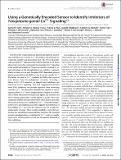Files in this item
Using a genetically encoded sensor to identify inhibitors of Toxoplasma gondii Ca2+ Signalling
Item metadata
| dc.contributor.author | Sidik, Saima M | |
| dc.contributor.author | Hortua Triana, Miryam A | |
| dc.contributor.author | Paul, Aditya S | |
| dc.contributor.author | El Bakkouri, Majida | |
| dc.contributor.author | Hackett, Caroline G | |
| dc.contributor.author | Tran, Fanny | |
| dc.contributor.author | Westwood, Nicholas J | |
| dc.contributor.author | Hui, Raymond | |
| dc.contributor.author | Zuercher, William J | |
| dc.contributor.author | Duraisingh, Manoj T | |
| dc.contributor.author | Moreno, Silvia N J | |
| dc.contributor.author | Lourido, Sebastian | |
| dc.date.accessioned | 2016-07-07T11:30:09Z | |
| dc.date.available | 2016-07-07T11:30:09Z | |
| dc.date.issued | 2016-04-29 | |
| dc.identifier | 243473320 | |
| dc.identifier | 66467b30-edb9-4362-bbec-cd07543b2779 | |
| dc.identifier | 26933036 | |
| dc.identifier | 26933036 | |
| dc.identifier | 84994200826 | |
| dc.identifier | 000375602300016 | |
| dc.identifier.citation | Sidik , S M , Hortua Triana , M A , Paul , A S , El Bakkouri , M , Hackett , C G , Tran , F , Westwood , N J , Hui , R , Zuercher , W J , Duraisingh , M T , Moreno , S N J & Lourido , S 2016 , ' Using a genetically encoded sensor to identify inhibitors of Toxoplasma gondii Ca 2+ Signalling ' , Journal of Biological Chemistry , vol. 291 , no. 18 , pp. 9566-9580 . https://doi.org/10.1074/jbc.M115.703546 | en |
| dc.identifier.issn | 0021-9258 | |
| dc.identifier.other | ORCID: /0000-0003-0630-0138/work/56424196 | |
| dc.identifier.uri | https://hdl.handle.net/10023/9085 | |
| dc.description | This work was supported in part by National Institutes of Health Grants AI-110027 and AI-096836 (to S. N. J. M.) and 1DP5OD017892 (to S. L.). | en |
| dc.description.abstract | The life cycles of apicomplexan parasites progress in accordance with fluxes in cytosolic Ca2+. Such fluxes are necessary for events like motility and egress from host cells. We used genetically encoded Ca2+ indicators (GCaMPs) to develop a cell-based phenotypic screen for compounds that modulate Ca2+ signaling in the model apicomplexan Toxoplasma gondii. In doing so, we took advantage of the phosphodiesterase inhibitor zaprinast, which we show acts in part through cGMP-dependent protein kinase (protein kinase G; PKG) to raise levels of cytosolic Ca2+. We define the pool of Ca2+ regulated by PKG to be a neutral store distinct from the endoplasmic reticulum. Screening a library of 823 ATP mimetics, we identify both inhibitors and enhancers of Ca2+ signaling. Two such compounds constitute novel PKG inhibitors and prevent zaprinast from increasing cytosolic Ca2+. The enhancers identified are capable of releasing intracellular Ca2+ stores independently of zaprinast or PKG. One of these enhancers blocks parasite egress and invasion and shows strong antiparasitic activity against T. gondii. The same compound inhibits invasion of the most lethal malaria parasite, Plasmodium falciparum. Inhibition of Ca2+-related phenotypes in these two apicomplexan parasites suggests that depletion of intracellular Ca2+ stores by the enhancer may be an effective antiparasitic strategy. These results establish a powerful new strategy for identifying compounds that modulate the essential parasite signaling pathways regulated by Ca2+, underscoring the importance of these pathways and the therapeutic potential of their inhibition. | |
| dc.format.extent | 15 | |
| dc.format.extent | 4162438 | |
| dc.language.iso | eng | |
| dc.relation.ispartof | Journal of Biological Chemistry | en |
| dc.subject | Calcium | en |
| dc.subject | Calcium intracellular release | en |
| dc.subject | Drug screening | en |
| dc.subject | Parasitology | en |
| dc.subject | Protein kinase G (PKG) | en |
| dc.subject | Signal Transduction | en |
| dc.subject | QH426 Genetics | en |
| dc.subject | NDAS | en |
| dc.subject | SDG 3 - Good Health and Well-being | en |
| dc.subject.lcc | QH426 | en |
| dc.title | Using a genetically encoded sensor to identify inhibitors of Toxoplasma gondii Ca2+ Signalling | en |
| dc.type | Journal article | en |
| dc.contributor.institution | University of St Andrews. School of Chemistry | en |
| dc.contributor.institution | University of St Andrews. EaSTCHEM | en |
| dc.contributor.institution | University of St Andrews. Biomedical Sciences Research Complex | en |
| dc.identifier.doi | https://doi.org/10.1074/jbc.M115.703546 | |
| dc.description.status | Peer reviewed | en |
| dc.identifier.url | http://www.jbc.org/content/291/18/9566/suppl/DC1 | en |
This item appears in the following Collection(s)
Items in the St Andrews Research Repository are protected by copyright, with all rights reserved, unless otherwise indicated.

